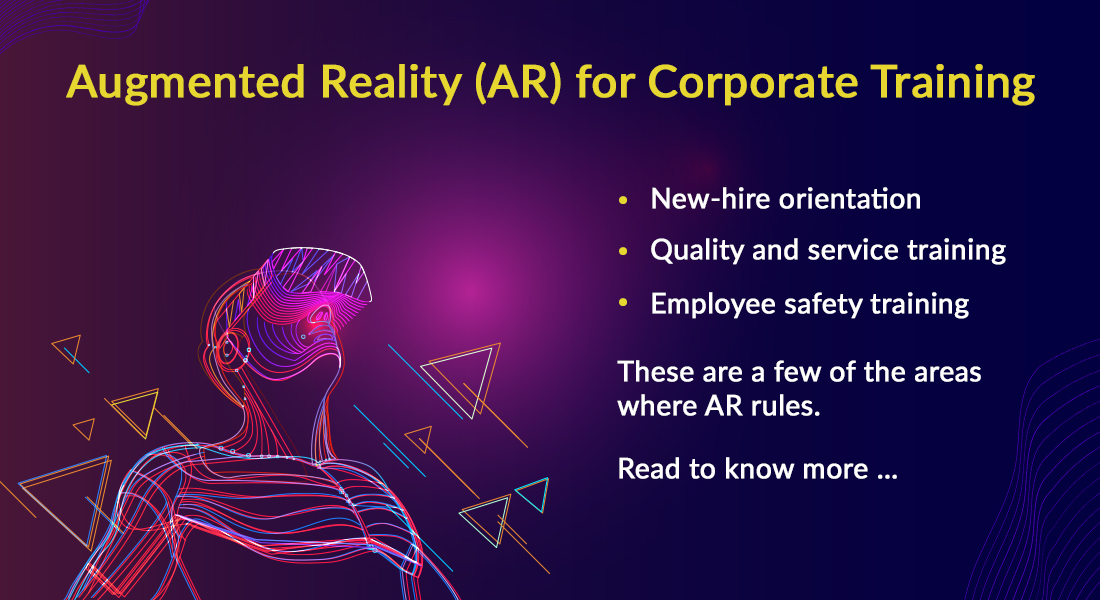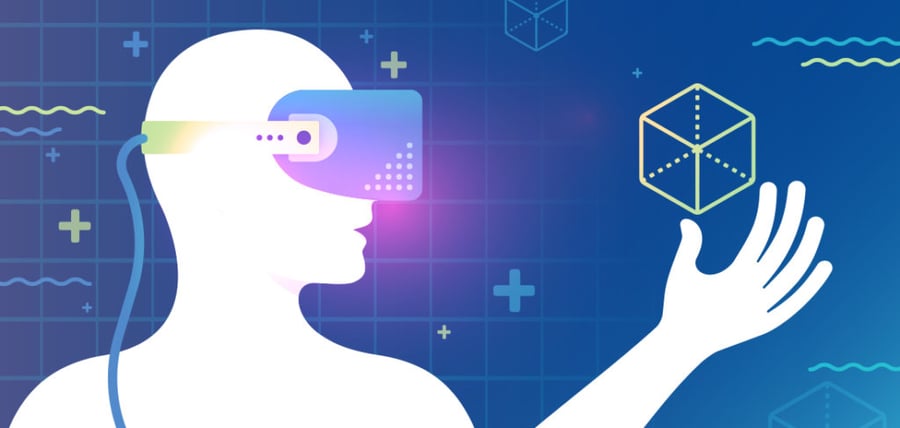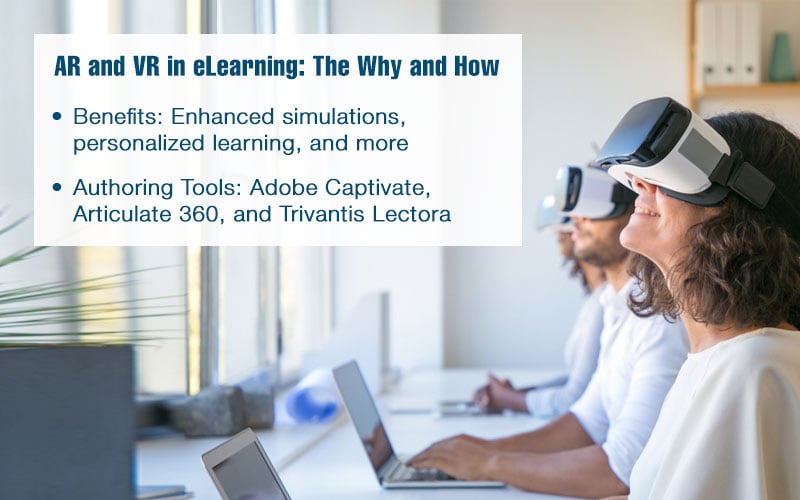The Ins and Outs of Augmented Reality (AR) for Corporate Training

Reality is merely an illusion, albeit a very persistent one.
– Albert Einstein
Augmented reality! Virtual reality! Mixed reality! Hang on, don’t go around throwing these terms at your senior management just so you can get those cool headsets for corporate training. In these difficult times with remote work being the new normal, I can understand the need to amp up your training game, but AR in corporate training is not for everyone. So why use up your training budget on AR goggles, VR headsets, controllers, powerful computers, and a huge physical training space?
Uses and Benefits of AR in Corporate Training
You can use AR in corporate training to:
- Improve the onboarding experience of new hires
- Reduce the risk in heavy machinery and equipment training
- Improve quality assessment and product service training
- Conduct and provide sound employee safety training.
If your training really needs AR, read this all-in-all blog on AR in corporate training. But be aware that this blog does not use impressive technical and corporate training terms just to show off; rather it tries to discuss the three ‘realities’ to paint you a better picture of which ‘reality’ suits your training needs the most.
→ Build Effective Learning Experiences through Microlearning: Click to learn How.
Understanding the Realities
Augmented Reality and Virtual Reality are two different approaches with the same outcome – of momentarily shaping your reality into something it is not. Apart from these two, a third “Mixed Reality” has also emerged of late, thanks to Microsoft’s work with HoloLens and HoloLens 2. Before jumping into how to use them for corporate training, let’s understand the differences among the three.
- Virtual Reality – VR provides an immersive experience where the entire outer world is shut off from vision. It uses dedicated VR devices like HTC Vive, Oculus Rift, Google Cardboard, or the recently released Valve Index.
- Augmented Reality – Augmented Reality, instead of shutting off the viewer’s visual field, superimposes digital or virtual elements on the real world through a transparent screen, like holograms or heads-up displays (HUD). AR devices are smaller, more compact, usable in mobile devices, and can even take the form of regular glasses.
- Mixed Reality – Mixed reality is an advanced blend of both virtual and augmented realities which not only projects holographic images, but can even use gesture and eye tracking to make the user interact with them on a deeper level.
As a person grounded in reality, I find Augmented Reality the perfect fit for different types of corporate training. It can be risky for the VR user to walk around in the real world (without supervision) wearing head mounted displays (HMD) which block their vision totally. AR, however, allows the user to also see the real world, thus reducing accidental trips and falls, or collisions during training. Besides, superimposed images and media assets on real life objects lead to better retention than a handout or PPT slides.

Now, without further ado, let’s take a look at how AR can support Corporate Training
Corporate Training with Augmented Reality: 4 Training Areas to Focus on
1. Onboarding / New Hire Orientation:
What better way to induct your new employees to the organization than with augmented reality? Not only is onboarding with AR exciting and innovative, it also reduces workload significantly by allowing users to explore and learn at the same time. Sounds confusing? Let me explain.
You can give a virtual tour of the organization using AR. The user can wear AR glasses and look around, while images, texts and interactive media pop up on the HUD, indicating which door leads to the manager’s office and which one to the cafeteria. Each element that the learner sees is superimposed on the real-life objects in such a manner that they appear overlapped. More advanced AR technology is also available (at more cost) that allows better interaction with the on-screen elements and enhanced responsiveness. Your new hires will love feeling like the Iron Man!
2. Heavy Equipment Training:
AR can greatly reduce the risks associated with heavy machinery and equipment training. The ability to overlay information virtually over actual physical spaces and objects makes AR an ideal tool to use in these cases. No wonder industries like agriculture, automobile, oil and gas, mining, and construction are relying on AR supported training.
Consider a scenario where you have to train a group of newcomers on operating a big fat machine, without risk to the learner or the machine (or both). Each step needs to be performed meticulously without error or accidental skipping. AR enables the learner to look at the machine while information related to its different parts, including a user manual and troubleshoot options, pops up wherever required. Now your learners will know perfectly well which buttons NOT to push during training.
3. Quality Assessment/ Product Service Training:
Another key training area where AR can be really useful is that of quality assessment. Your learners need to know what to check for when testing the quality of a product. AR can be a more valuable training support here than guidebooks or manuals.
A 2017 study showed that helped by an intelligent tutoring system while using AR, motherboard assembly trainees were able to improve their test scores and performance time by 25% and 30% respectively. This shows the potential of AR in the field of quality assessment training of both small and large equipment. AR minimizes the risk involved with different types of training, meaning the learners can learn, assess, as well as make mistakes in the virtual environment without real-life implications. Once they hone their skills, they can move on to the real world.
4. Employee Safety Training:
Augmented reality in employee safety training can dramatically reduce operational costs and training risks by creating safe simulations of unsafe situations. Creating realistic training scenarios can be dangerous as well as expensive. Plus, given that employee safety is such an important aspect of corporate training, AR in training also helps the learners retain information better than any safety instruction guidebook or PowerPoint deck.
Using advanced machine learning programs and computer vision, AR glasses can even track potential safety issues, or simulate actual unsafe situations for the learners to interact with, understand, and learn.
AR technology can also help identify issues with OSHA (Occupational Safety and Health Administration) safety compliance. Simply pointing your phone camera towards a specific situation can tell you if the workspace is violating any OSHA safety guidelines. ‘Formaspace’, the industrial furniture company, had used AR for employee safety training and found manufacturing safety violations in respiratory protection and woodworking machinery requirements, amongst others.
Benefits of Training with AR
When it comes to corporate training using eLearning, AR can play quite a robust role. Here’s how.
- Immersive Online Training Through AR Simulations – Unlike conventional simulations in eLearning which have a lot of scope for distraction, AR simulations completely immerse the user audio-visually, thus improving training outcomes.
- Realistic Gamification of eLearning Courses – While gamification of eLearning courses has been a real game changer (no pun intended), adding elements of gamification in AR based training can improve results by letting learners physically experience rewards (points and badges), and even climb up the leaderboard.
- Visual Feedback in Assessments – Thanks to AR based testing and assessment, not only do learners perform real-life tasks in a simulated environment for testing, their actions are also recorded for them to replay and identify missed steps and mistakes.
- Advanced Learning Analytics – The new Microsoft HoloLens allows eye-tracking – scrolling up and down just using your eyes. AR based training can provide highly detailed learning analytics like eye movements which indicate a point of interest/conflict in the training.
Switching Off!
Feeling enlightened? That is probably because you now have the power to build a case for bringing AR (and/or VR) in your corporate training. But then again, I understand that you cannot use up all your training budget on AR headsets, they have to make a meaningful contribution to your organization.
While you think about all the things you could do with AR, here is an eBook on all the cool trendy things you can do NOW with eLearning in your organization. Have a look.




![Leveraging AR/VR Technology in eLearning [5 Best Ways + Advantages + Disadvantages]](https://blog.commlabindia.com/hubfs/Imported_Blog_Media/Leveraging-ARVR-Technology-in-eLearning-5-Best-Ways-Advantages-Disadvantages.jpg)
